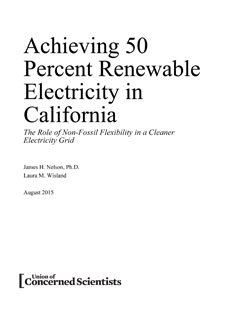Ramping up renewable energy in California is essential to lowering carbon emissions from the state's electricity sector. Renewable energy can also reduce emissions in the transportation sector by powering electric vehicles.
As California moves toward increasing renewable energy beyond the current requirement of 33 percent by 2020, the state’s approach to managing the electricity grid needs to evolve to take full advantage of its low-carbon resources.
For example, natural gas power plants could generate electricity and provide reliability services when there is an ample supply of renewable energy available. In this scenario, electricity produced by natural gas power plants could “crowd out” renewable generation by forcing the grid operator to curtail renewables to avoid a situation in which electricity supply exceeds demand. This can result in a missed opportunity to take full advantage of renewable generation, and creates additional carbon emissions in the process.
To maximize the use of renewable energy, the electricity grid needs to ensure that clean energy resources are fully utilized when available.
Our analysis
The analysis modeled a California power system that relies on renewable energy to meet 50 percent of the state’s retail electricity demand.
The analysis shows that ramping up renewable energy to this level is possible with the technology we have in place now, but it can be done more effectively—and result in greater carbon reductions—with additional tools and smart investments in the electricity grid.
Key findings include:
- The modeling demonstrates that California can integrate 50 percent renewable energy into our electricity mix by 2024, faster than envisioned by current state proposals.
- If California makes no additional investment in grid flexibility beyond projected levels, raising the Renewables Portfolio Standard from 33 percent to 50 percent would reduce greenhouse gas emissions from electricity generation by 22 percent. This will be accomplished largely by producing energy with renewables instead of natural gas. But if California uses additional low or zero-carbon grid management methods such as storage, demand response, electricity exports, and more flexible operation of renewable generators, greenhouse gas emissions would drop by 27 percent.
- The long-term goal of reducing greenhouse gas emissions in the electricity system will require integrating more renewable energy and turning down gas power plants as much as possible. The modeling results suggest that the ramping ability of existing combustion turbine and peaker gas plants will be sufficient in 2024, and installation of additional gas capacity to meet ramping needs would not be warranted.
- If wind and solar power are allowed to play a bigger role in providing reliability services, 44 percent less renewable energy would be curtailed.
- California can also maintain adequate grid flexibility and reliability while reducing reliance on natural gas by deploying a combination of advanced demand response—which shifts energy consumption to periods when the grid needs it the most — and energy storage like batteries. These technologies can help to reduce renewable energy curtailment and carbon emissions. In some cases, these grid management solutions deliver even greater flexibility than natural gas because they can provide grid reliability services without having to be online and simultaneously generating electricity.





